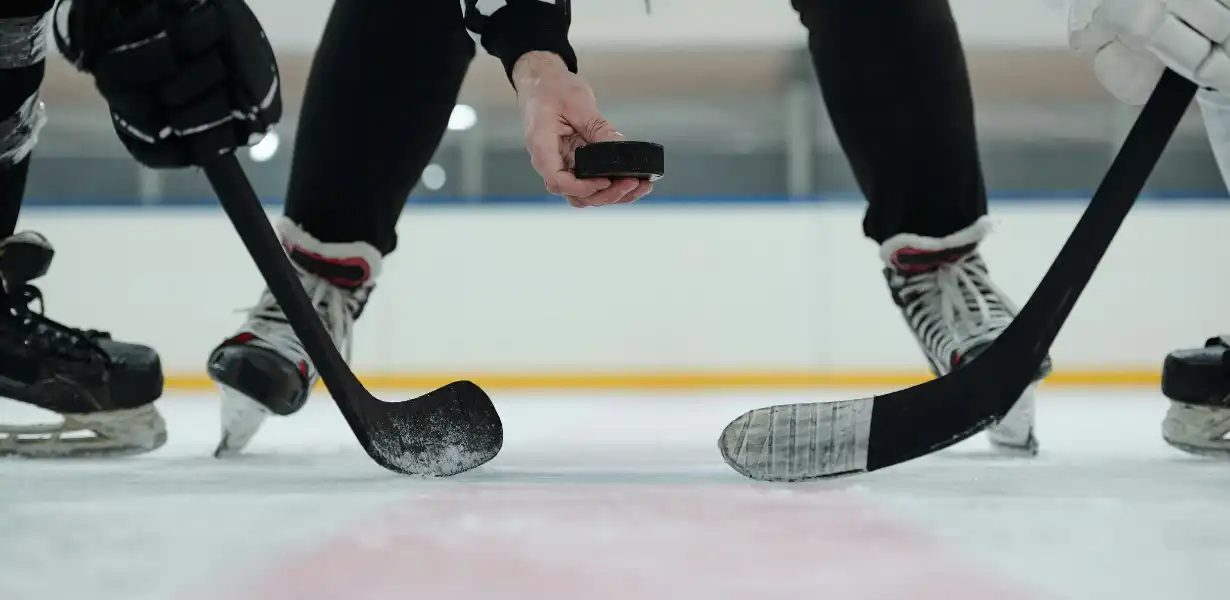Faceoffs are one of the most underrated yet critical aspects of hockey. Every puck drop can shift momentum, spark scoring chances, and set the tone for an entire game. But a question that many fans ask is: Who chooses the faceoff circle?
The answer lies in a blend of rulebook guidelines, referee authority, and game situations. Understanding how faceoff locations are determined not only helps fans follow the game but also highlights just how strategic this part of hockey truly is.
What is a Faceoff in Hockey?
A faceoff is the method used to start play at the beginning of periods, after goals, and following stoppages. Two opposing players line up at one of the designated faceoff spots, waiting for the referee or linesman to drop the puck.
How Many Faceoff Circles Are on the Ice?
An NHL rink has a total of five faceoff circles:
- Two circles in each team’s zone (one on the left side and one on the right side inside the blue line).
- One circle at center ice.
That makes five full circles in total.
In addition, there are four more neutral zone dots (two on each side of the rink between the blue lines). These aren’t full circles but are still used for faceoffs when offsides or certain stoppages occur.
So overall, there are nine total faceoff locations: five circles plus four neutral zone dots.
Who Chooses the Faceoff Circle?
The referees and linesmen are responsible for determining the exact faceoff location. Players, coaches, and even captains don’t get to “choose” where the puck will be dropped. Instead, the decision is made based on why play was stopped and who caused the stoppage.
Here’s a breakdown:
1. After an Offside
• If a team goes offside, the faceoff happens in the neutral zone closest to where the infraction occurred.
2. After Icing
• If a team ices the puck, the faceoff takes place in their own defensive zone. The attacking team gets a significant advantage here.
3. After a Goalie Freeze
• If the goalie covers the puck, the faceoff is in the defending zone circle closest to where the puck was frozen.
4. After a Penalty
• Following a penalty call, the faceoff occurs in the non-offending team’s defensive zone, unless another situation dictates otherwise.
5. After Goals and Period Starts
• These always restart at center ice.
So, while the referees make the call, the cause of the stoppage is what truly determines the circle.
Why the Faceoff Location Matters
Every faceoff is a mini-battle for possession. Winning a draw in the offensive zone can immediately create a scoring chance, while losing one in the defensive zone can put your goalie under pressure.
Some key impacts include:
• Momentum Shifts – Offensive zone draws after an icing pin an exhausted defense.
• Special Teams Advantage – Power plays often start with critical offensive zone faceoffs.
• Line Strategy – Coaches match up their best centers in high-leverage circle battles.
Simply put: the faceoff circle location can tilt the ice one way or the other.
Player Strategy in the Circle
Centers prepare meticulously for faceoffs. They study opponents, adjust grip, and anticipate referee timing. Wingers and defensemen also play roles, ready to pounce on loose pucks once the puck hits the ice.
Even though players don’t choose the faceoff circle, they adjust their strategy based on location. A draw in the defensive zone means prioritizing puck safety, while one in the offensive zone encourages quick shots or set plays.
NHL Rules on Faceoff Locations
The NHL Rulebook spells it out clearly:
• Rule 76: Faceoffs occur at the nearest faceoff spot outside the defending team’s zone if the attacking team causes a stoppage.
• Neutral zone dots are used for offsides and certain deflections.
• If there’s uncertainty, officials have discretion to choose the most “fair” location.
That’s why you’ll often hear announcers explain the reason for the faceoff circle selection during broadcasts.
Common Misconceptions
• “The captain gets to choose the circle.”
False—captains can talk to referees, but they don’t make the call.
• “The last team to touch the puck gets the faceoff advantage.”
Not always—icing and penalties change the equation.
• “It’s random.”
Every faceoff has a specific rule-based reason for its location.
Why This Rule Makes Hockey Better
The consistency of who chooses the faceoff circle keeps the game fair. If teams could choose, they’d always opt for the offensive zone. Instead, referees enforce the rules to make sure accountability and flow of play stay intact.
It also adds a layer of strategy—teams must adapt to situations rather than dictate them. That’s part of what makes hockey so exciting.
Final Buzzer
So, who chooses the faceoff circle? It’s ultimately the referees, guided by the official rulebook and the cause of the stoppage. Players may not control the circle, but they control what happens once the puck hits the ice.
Faceoffs may seem like a small part of the game, but every single one matters. They decide puck possession, scoring chances, and sometimes the outcome of an entire game. The next time you’re watching hockey, keep an eye on the circles—you’ll see just how much strategy is packed into those few seconds before the puck drops.

